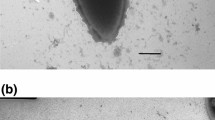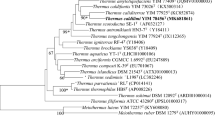Abstract
The isolation of a new anaerobic thermophilic bacterium, Thermoanaerobium brockii, from volcanic features is described. Successful enrichment required a complex medium containing glucose or other fermentable sugars and incubation temperatures of 55–80° C. Strains of T. brockii were gram positive, rods of uneven length that existed singly, in pairs, chains or filaments. Electron micrographs of thin sections of cell revealed a monolayered cell wall and a constrictive or “pinching off” cell division process. The organism was nonsporeforming, obligately anaerobic and chemoorganotrophic. The optimal temperature for growth was 65–70° C, the maxium was below 85° C and the minimum above 35° C. The doubling time at the optimal temperature for growth was about 1 h. The DNA base composition of three strains of T. brockii varied from 30.0–31.4 mol % guanosine plus cytosine. Fermentable carbohydrates included glucose, sucrose, maltose, lactose, cellobiose and insoluble starch. The fermentation products of cells grown on glucose were ethanol, lactic acid, acetic acid, hydrogen and carbon dioxide. Growth of all strains tested was inhibited by fairly low concentrations of cycloserine, penicillin, streptomycin, tetracycline and chloramphenicol. The possible ecological, evolutionary, and industrial significance, and taxonomic relationships of Thermoanaerobium are discussed.
Similar content being viewed by others
Abbreviations
- TYEG:
-
complex medium containing mineral salts, 0.3% yeast extract, 1.0% tryptone and 0.5% glucose
- O.D.:
-
optical density
- G+C:
-
guanosine plus cytosine
References
Badziong, W., Thauer, R. K., Zeikus, J. G.: Isolation and characterization of Desulfovibrio growing on hydrogen plus sulfate as the sole energy source. Arch. Microbiol. 116, 41–49 (1978)
Brock, T. D.: Thermophilic microorganisms and life at high temperatures. Berlin-Heidelberg-New York: Springer (1978)
Brock, T. D., Freeze, H.: Thermus aquaticus gen. n. and sp. n., a nonsporulating extreme thermophile. J. Bacteriol. 98, 289–297 (1969)
Bryant, M. P.: Commentary on the Hungate technique for culture of anaerobic bacteria. Am. J. Clin. Nutr. 25, 1324–1328 (1972)
Buchanan, R. E., Gibbons, N. E.: Bergey's Manual of Determinative Bacteriology, 8th ed. Baltimore: The Williams and Wilkins Co. (1974)
DeLey, J.: Reexamination of the association between melting point, buoyant density and the chemical base composition of deoxyribonucleic acid. J. Bacteriol. 101, 738–754 (1970)
Doemel, W. N., Brock, T. D.: Structure, growth, and decomposition of laminated algal-bacterial mats in alkaline hot springs. Appl. Environ. Microbiol. 34, 433–452 (1977)
Duncan, C. L., Strong, D. H.: Improved medium for sporulation of Clostridium perfringens. Appl. Microbiol. 16, 82–89 (1968)
Gilleland, H. E., Murray, R. G. E.: Demonstration of cell division by septation in a variety of gram-negative rods. J. Bacteriol. 121, 721–725 (1975)
Gunter, B. D., Musgrave, B. C.: Gas chromatographic measurements of hydrothermal emanations at Yellowstone National Park. Geochim. Cosmochim. Acta 30, 1175–1189 (1966)
Hollaus, F., Sleytr, U.: On the taxonomy and fine structure of some hyperthermophilic saccharolytic clostridia. Arch. Mikrobiol. 86, 129–146 (1972)
Hsu, E. J., Ordal, Z. J.: Comparative metabolism of vegetative and sporulating cultures of Clostridium thermosaccharolyticum. J. Bacteriol. 102, 369–376 (1970)
Kushner, D. J. (ed.): Microbial Life in Extreme Environments. London: Academic Press 1978
Lee, L. K., Ordal, Z. J.: Regulatory effect of pyruvate on the glucose metabolism of Clostridium thermosaccharolyticum. J. Bacteriol. 94, 530–536 (1967)
Ljungdahl, L. G.: Thermophilic microorganisms. Adv. Microbiol. Physiol. (in press)
Marmur, J.: A procedure for the isolation of deoxyribonucleic acid from microorganisms. J. Mol. Biol. 3, 208–218 (1961)
Matteuzzi, D., Hollaus, F., Biavati, B.: Proposal of neotype for Clostridium thermohydrosulfuricum and the merging of Clostridium tartarivorum with Clostridium thermosaccharolyticum. Int. J. Syst. Bacteriol. 28, 528–531 (1978)
Nelson, D. R., Zeikus, J. G.: Rapid method for the radioisotopic analysis of gaseous products of anaerobic metabolism. Appl. Environ. Microbiol. 28, 258–261 (1974)
Sleytr, U. B., Glauert, A. M.: Ultrastructure of the cell walls of two closely related clostridia that possess different regular arrays of surface subunits. J. Bacteriol. 126, 869–882 (1976)
Thauer, R. K., Rupprecht, E., Jungermann, K.: Separation of 14C-formate from CO2 fixation metabolites by isoionic exchange chromatography. Anal. Biochem. 38, 461–468 (1970)
Weimer, P. R., Zeikus, J. G.: Fermentation of cellulose and cellobiose by Clostridium thermocellum in the absence and presence of Methanobacterium thermoautotrophicum. Appl. Environ. Microbiol. 33, 289–297 (1977)
Williams, R. A. D.: Caldoactive and thermophilic bacteria and their thermostable proteins. Sci. Prog. (Oxford) 62, 373–394 (1975)
Winfrey, M., Zeikus, J. G.: Microbial methanogenesis and acetate metabolism in a meromictic lake. Appl. Environ. Microbiol. 37, 244–253 (1979)
Woese, C. R., Magrum, L. J., Fox, G. E.: Archaebacteria. J. Mol. Evol. 11, 245–252 (1978)
Wolin, E. A., Wolin, M. J., Wolfe, R. S.: Formation of methane by bacterial extracts. J. Biol. Chem. 238, 2882–2886 (1963)
Zeikus, J. G., Brock, T. D.: Effects of thermal additions from the Yellowstone Geyser Basins on the bacteriology of the Firehole River. Ecology 53, 283–290 (1972)
Zeikus, J. G., Bowen, V. G.: Fine structure of Methanospirillum hungatii. J. Bacteriol. 121, 373–380 (1975)
Zeikus, J. G., Winfrey, M. R.: Temperature limitation of methanogenesis in aquatic sediments. Appl. Environ. Microbiol. 31, 99–107 (1976)
Author information
Authors and Affiliations
Rights and permissions
About this article
Cite this article
Zeikus, J.G., Hegge, P.W. & Anderson, M.A. Thermoanaerobium brockii gen. nov. and sp. nov., a new chemoorganotrophic, caldoactive, anaerobic bacterium. Arch. Microbiol. 122, 41–48 (1979). https://doi.org/10.1007/BF00408044
Received:
Issue Date:
DOI: https://doi.org/10.1007/BF00408044




